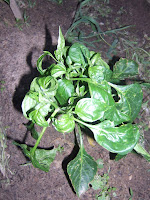This morning, I spoke with Richard Nelson, the editor of the JDProgress about the Master Gardeners’ column. Following are the specifics:
Cherokee County Master Gardeners Monthly Column in the Jacksonville Daily Progress
Who? – Members of the Master Gardeners Assn. will send information to me about a specific subject. It does not need to be a finished article or even written in complete sentences. I can put it into a finished form if necessary. If you do not type, I will be happy to interview you about your chosen topic. Although I will be the contact person, all members of the association will contribute to this effort. Each of us has his/her area of expertise or interest.
What? – We need articles on topics relevant to Cherokee County . Possibilities include specific plants (annuals, perennials, shade, sun…), shrubs, trees, small ponds, landscaping, walkways, walls, garden fences, composting, irrigation, pests, weed control, vegetables, fruit trees, greenhouses, propagation (cuttings, seeds…), internet resources, dealing with drought (xeriscape, etc.), local water problems, winter tasks, etc. The possibilities are endless. Other topics that come to mind for our area are how to prune shrubs (especially, how NOT to murder Crepe Myrtles!), how to use (and not fight) the natural beauty of East TX as a backdrop to home landscaping, what to do with a native vine invasion (Virginia Creeper!), safely dealing with poison ivy, etc. Photos – We can include a photo with each article. Photo suggestions – close ups of specific plants and/or a picture of the Master Gardener who submitted the article with whatever subject (plant, greenhouse, compost pile, etc.). I will be happy to take the picture or you can send it to me along with your article by email. Pictures should have high contrast, be uncluttered and very clear. If you cannot send the picture by e-mail, I can borrow it, scan it, and then return it to you.
Mr. Nelson said they never know how much space they will have, but roughly 500 words would be a safe length for the articles.
When? – The newspaper wants to have at least 2 articles on hand each month in case something happens and we are slow submitting one for the next month. I, on the other hand, would like to have a whole FILE of future articles – even a year in advance! – so that I can get him two this first month (June, ’08), and one each month thereafter. Because it is now late spring/early summer, you might want to take photos of blooming plants, etc. while you can – even if you don’t write the article (or send me the info. so that I can write the article) until later. In other words, get busy now and do not think one article is enough!!! Our column will probably run the last Sunday of the month.
How? – As mentioned above, you can send your article (or info.) and photograph to me at this address moak@suddenlink.net , bring it (them) to the next Master Gardeners’ meeting, or mail it (them) to me –
Kathy Moak
220 Beach St.
Jacksonville, TX 75766.
If you need for me to take a photo, give me a call – (home) 903-586-4548 (cell) 903-752-1331.
Why? – The purpose of this monthly column is to assist Cherokee County residents with gardening/landscaping while at the same time promote the Master Gardener program. This regular newspaper column is an excellent opportunity to do both. However, the effort will not be successful without the cooperation of each and every Master Gardener.
I am looking forward to receiving your articles!
~Kathy Moak
 I would like for one or two Master Gardeners to learn and teach drying and preserving flowers and plant materials. It would be a wonderful addition to our classes. The web site below is a good starting place.
I would like for one or two Master Gardeners to learn and teach drying and preserving flowers and plant materials. It would be a wonderful addition to our classes. The web site below is a good starting place.














